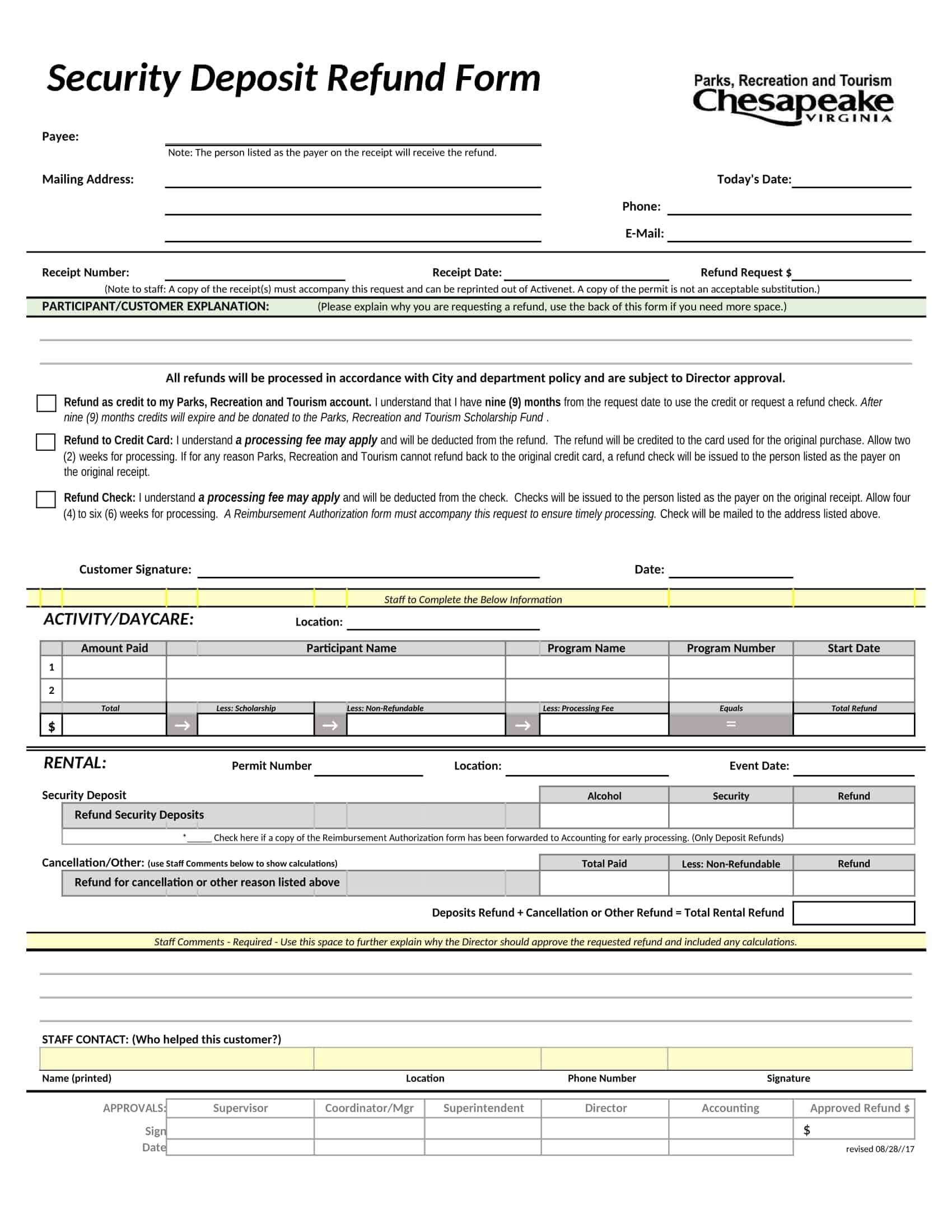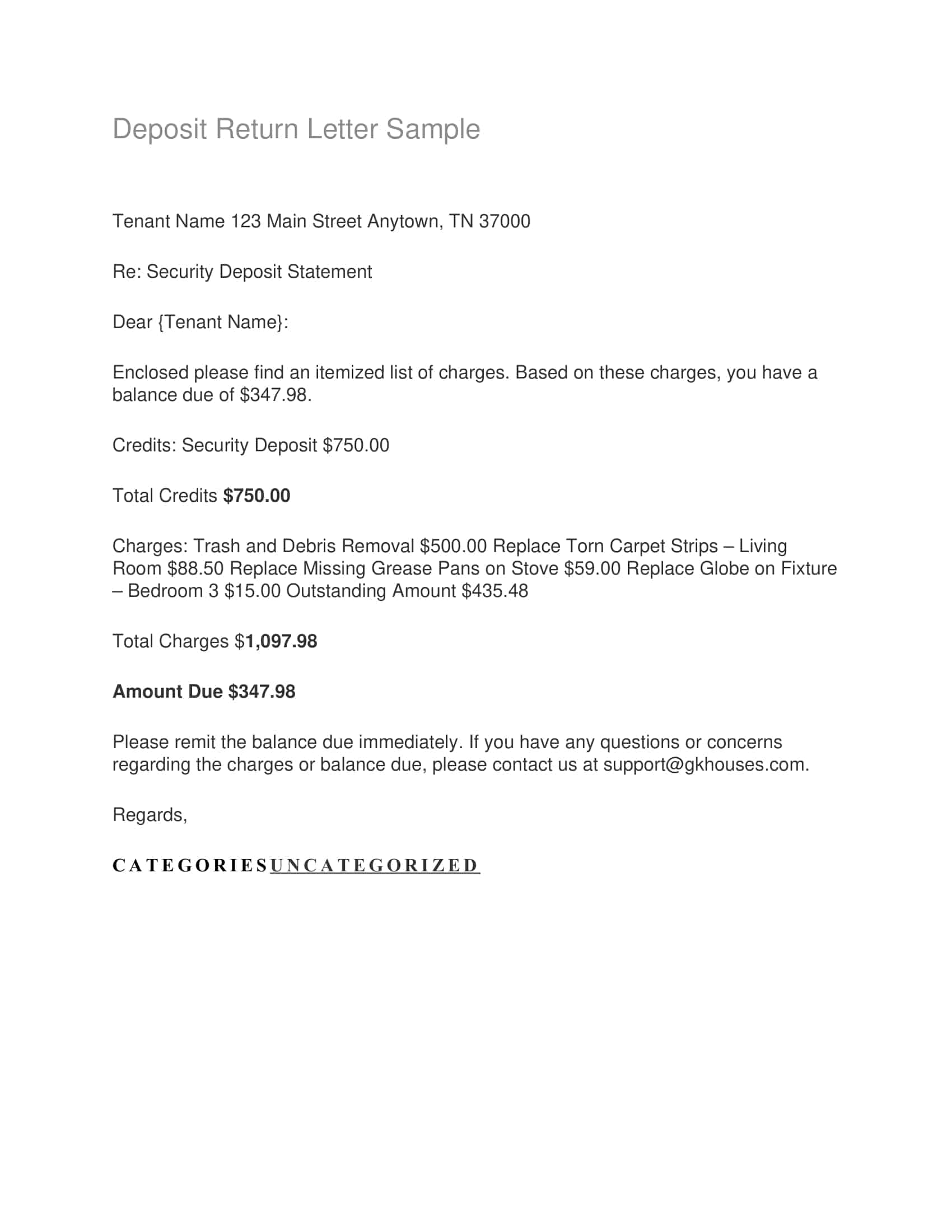A security deposit is a common practice where the landlord requests a certain amount of money from the tenant before they move in, which serves as a guarantee that any damages that may occur to the property during the tenant’s stay will be covered. At the end of the tenancy, if there is little or no damage, the tenant can request the return of the security deposit through a security deposit return letter.
This letter is an official request for the refund and serves as a way to document any deductions or damages that the landlord may claim from the deposit, it’s important for both tenant and landlord to understand the process of returning the security deposit and to ensure that it is done fairly and promptly.
Table of Contents
Security Deposit Return Letter Templates
Ensure a smooth and transparent process for returning security deposits with our comprehensive collection of Security Deposit Return Letter Templates. These customizable and printable templates provide a formal and professional framework for landlords to communicate the details of security deposit returns to tenants. Our templates include sections for property details, deposit amount, deductions (if any), and the final refund amount.
By utilizing our Security Deposit Return Letter Templates, landlords can effectively document the return of security deposits, provide transparency in accounting, and maintain positive landlord-tenant relationships. Streamline your deposit return process, protect your legal obligations, and foster trust and satisfaction with our user-friendly templates. Download now and facilitate a hassle-free return of security deposits with confidence and clarity.
When do you need a security deposit return letter?

A security deposit return letter is typically needed when a tenant moves out of a rented property and wishes to request the return of their security deposit from the landlord. The letter serves as a formal request for the refund and documents any deductions or damages that the landlord may claim from the deposit.
It’s important to note that laws and regulations regarding security deposit return letters may vary depending on the jurisdiction, but generally, the tenant is required to send the letter within a certain timeframe after they move out. Some laws dictate that the letter should be sent within a certain number of days of the tenant vacating the property, while other laws may require the letter to be sent within a certain number of days of the landlord returning the deposit.
Additionally, the letter can be used by the landlord as a proof that they’ve returned the security deposit in case of any disputes that may arise later.
What to Include in a Security Deposit Return Letter
A security deposit return letter should include the following information:
Identification of the tenant and the property: The letter should include the tenant’s name, address, and contact information, as well as the address of the rental property.
Request for security deposit refund: The letter should clearly state that the tenant is requesting the return of their security deposit and the amount of the deposit.
Dates of occupancy: The letter should include the dates of the tenant’s occupancy of the property, including the move-in and move-out dates.
Description of the property’s condition: The letter should include a detailed description of the condition of the property at the time of move-out, including any damages or issues that the tenant is aware of.
Receipt or proof of payment of the deposit: The letter should include a copy of the receipt or proof of payment of the security deposit, if available.
Contact information: The letter should include the tenant’s contact information, such as phone number and email address, so the landlord can easily get in touch with them.
Return mailing address: The letter should include the tenant’s mailing address where the security deposit should be returned.
Compliance with local laws: The letter should comply with any local laws and regulations regarding security deposit return letters, such as the time frame for sending the letter or the process for resolving disputes.
Common Reasons for not returning a tenant’s security deposit
A landlord may not return a tenant’s security deposit for various reasons, some of the common reasons include:
Damage to the property: The landlord may claim damages to the property caused by the tenant during their tenancy and deduct the costs of repair or replacement from the security deposit.
Unpaid rent or utility bills: The landlord may deduct any unpaid rent or utility bills from the security deposit.
Cleaning costs: The landlord may charge the tenant for cleaning costs if the property was left in an excessively dirty or unkempt condition.
Breach of lease agreement: The landlord may keep all or part of the security deposit if the tenant breaches the lease agreement, for example by keeping pets in the rental property or subletting without permission.
Improper move-out notice: The landlord may not return the deposit if the tenant did not give the proper notice before moving out as stated in the lease agreement.
Unauthorized modifications: The landlord may not return the deposit if the tenant made unauthorized modifications to the rental property, such as painting the walls or installing fixtures without permission.
How to Write a Security Deposit Return Letter to Your Tenant
When writing a security deposit return letter to your tenant, it’s important to be clear and professional. Here’s a general format you can follow:
Start with your contact information
Include your name, address, phone number, and email address at the top of the letter.
Identify the tenant and the rental property
Include the tenant’s name and address, and the address of the rental property in the letter.
State the amount of the security deposit
Clearly state the amount of the security deposit and when it was received.
Explain any deductions from the deposit
If you are retaining any portion of the deposit, explain the reason for the deductions and provide an itemized list of damages and the cost of repairs.
Provide the remaining balance of the deposit
If any portion of the deposit is being returned, include the remaining balance and the method of refund (e.g. check or direct deposit).
Include the deadline for the tenant to dispute the deductions
Include the date by which the tenant must dispute the deductions if they disagree with them.
End with your signature
Close the letter with your signature, and include any additional contact information if needed.
How to Justify Not Returning the Entire Deposit
If you are in a situation where you are considering not returning the entire deposit to a tenant, it is important to have a clear and valid reason for doing so. A common reason for retaining part of a deposit is to cover damages that the tenant has caused to the rental property during their tenancy. In order to justify not returning the entire deposit, it is important to document and provide evidence of the damages, such as photographs and repair estimates.
Additionally, it is important to communicate with the tenant and provide them with an explanation of why the deposit is being retained and the amount that will be kept. It’s also important to follow the laws and regulations of your state, as they may have specific rules on security deposit deductions and refunds.
Sample Security Deposit Return (Refund) Letter
[Your Name]
[Your Address]
[City, State ZIP Code]
[Email Address]
[Phone Number]
[Date]
[Tenant’s Name]
[Tenant’s Address]
[City, State ZIP Code]
Dear [Tenant’s Name],
I am writing to inform you that your security deposit of [$amount] has been returned in full. We would like to thank you for your tenancy and for keeping the rental property in good condition.
If you have any questions or concerns, please do not hesitate to contact me.
Sincerely,
[Your Name]
Another Type Sample Security Deposit Return (Refund) Letter
[Tenant’s Name]
[Tenant’s Address]
[City, State ZIP Code]
Dear [Tenant’s Name],
I am writing to inform you that your security deposit of [$amount] has been returned with a deduction of [$amount] for damages caused to the rental property during your tenancy. The damages were as follows: [list of damages]. We have also deducted [$amount] for unpaid rent. We have attached the receipts for the repairs and cleaning to this letter.
We understand that damages can occur during tenancy, however, we hope that you will understand our need to deduct the cost of repairs from your security deposit. We would like to thank you for your tenancy and hope that you will consider renting from us in the future.
If you have any questions or concerns, please do not hesitate to contact me.
Sincerely,
[Your Name]
FAQs
When should a security deposit return letter be sent?
A security deposit return letter should be sent to the tenant within the timeframe specified by state law after the tenant has moved out and returned the keys to the rental property. Typically, this is within 14 to 60 days of the tenant’s move-out date.
Can a landlord keep the security deposit?
A landlord can keep all or a portion of the security deposit if the tenant has caused damages to the rental property or if there is unpaid rent. However, the landlord must provide a written explanation of the damages and the cost of repairs in the security deposit return letter and follow the laws and regulations of the state.
What should a tenant do if they disagree with the security deposit deductions?
If a tenant disagrees with the security deposit deductions, they should reach out to the landlord in writing and request an explanation or provide evidence to refute the deductions. If the issue cannot be resolved through communication, the tenant may have to pursue legal action.
Can a landlord charge a non-refundable deposit?
Many states do not allow landlords to charge non-refundable deposits, but some states permit it under certain circumstances. It’s important for both landlord and tenant to check state laws and regulations before entering into a lease agreement.
What should a tenant do if they don’t receive their security deposit back?
If a tenant does not receive their security deposit back within the timeframe specified by state law, they should contact the landlord in writing and ask for the deposit to be returned. If the landlord does not respond or refuses to return the deposit, the tenant may have to take legal action.
Can a security deposit be used for cleaning or repairs?
A security deposit can be used for cleaning or repairs if the tenant has caused damages to the rental property or if they left the unit in an excessively dirty condition. However, the landlord must provide a written explanation of the damages and the cost of repairs in the security deposit return letter and follow the laws and regulations of the state.
What happens to the security deposit if the landlord sells the property?
When a landlord sells the property, the new owner is typically responsible for returning the security deposit to the tenant. However, it’s best for the tenant to communicate with the new landlord and make sure that their deposit is being transferred and returned as required by law.
Can a security deposit be used for unpaid rent?
A security deposit can be used for unpaid rent if the tenant has not paid the rent in full. However, the landlord must provide a written explanation of the unpaid rent in the security deposit return letter and follow the laws and regulations of the state.





















































![%100 Free Hoodie Templates [Printable] +PDF 1 Hoodie Template](https://www.typecalendar.com/wp-content/uploads/2023/05/Hoodie-Template-1-150x150.jpg)
![Free Printable Bank Deposit Slip Examples [Filled Out] +PDF 2 Bank Deposit Slip](https://www.typecalendar.com/wp-content/uploads/2023/05/Bank-Deposit-Slip-1-150x150.jpg)
![Free Printable Morse Code Charts [Numbers, Alphabet] 3 Morse Code Chart](https://www.typecalendar.com/wp-content/uploads/2023/09/Morse-Code-Chart-150x150.jpg)
